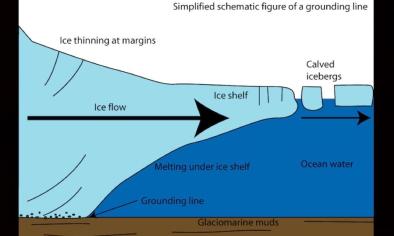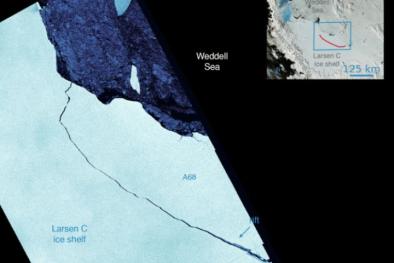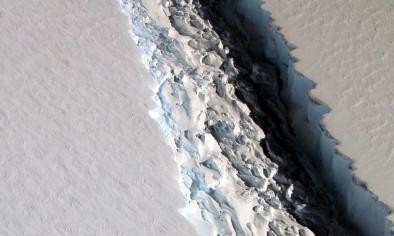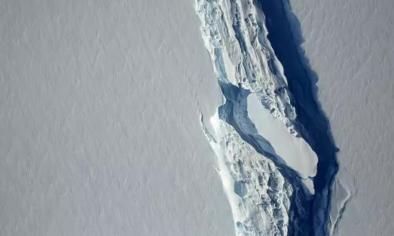Foehn jets over the Larsen C Ice Shelf, Antarctica
Previously unknown foehn jets have been identified to the east of the Antarctic Peninsula (AP) above the Larsen C Ice Shelf. These jets have major implications for the east coast of the AP, a region of rapid climatic warming and where two large sections of ice shelf have collapsed in recent years.
During three foehn events across the AP, leeside warming and drying is seen in new aircraft observations and simulated well by the Met Office Unified Model (MetUM) at ∼1.5 km grid spacing. In case A, weak southwesterly flow and an elevated upwind inversion characterise a highly nonlinear flow regime with upwind flow blocking. In case C strong northwesterly winds characterise a relatively linear case with little upwind flow blocking. Case B resides somewhere between the two in flow regime linearity.
The foehn jets – apparent in aircraft observations where available and MetUM simulations of all three cases – are mesoscale features (up to 60 km in width) originating from the mouths of leeside inlets. Through back trajectory analysis they are identified as a type of gap flow. In cases A and B the jets are distinct, being strongly accelerated relative to the background flow, and confined to low levels above the Larsen C Ice Shelf. They resemble the ‘shallow foehn’ of the Alps. Case C resembles a case of ‘deep foehn’, with the jets less distinct. The foehn jets are considerably cooler and moister relative to adjacent regions of calmer foehn air. This is due to a dampened foehn effect in the jet regions: in case A the jets have lower upwind source regions, and in the more linear case C there is less diabatic warming and precipitation along jet trajectories due to the reduced orographic uplift across the mountain passes.
...
The ice shelves surrounding the Antarctic Peninsula (AP) have been in a state of retreat over the past 50 years (Vaughan et al., 2001). On the AP's east coast, for example, the Larsen A and B Ice Shelves collapsed in 1995 and 2002 respectively (Vaughan and Doake, 1996; Rignot et al., 2004).
Surface melt due to atmospheric warming is thought to be the main driver of the ice loss (Scambos et al., 2000; van den Broeke, 2005). Indeed, the AP has been one of the fastest warming regions on Earth over the previous 50 years (Vaughan et al., 2003).
Marshall et al. (2006) revealed a link between east coast AP warming and the strength of the circumpolar vortex. The circumpolar vortex promotes the westerly transport of warm, moist air from across the Southern Ocean and Bellingshausen Sea to impinge on the Peninsula. If the westerly winds are relatively weak, the low-level eastward transport of these air masses (which are usually stably stratified) is blocked by the AP, especially to the south where the Peninsula is bounded by high mountains (Orr et al., 2008). Under these circumstances, the east side of the AP is commonly cooler than the west, with cold air of continental origin residing above the Larsen C Ice Shelf, and the AP's west coast being on average 3–5 °C warmer at near-surface level than its east coast at the same latitude (Morris and Vaughan, 2003).
The circumpolar vortex has strengthened in association with a positive shift towards the high-polarity index of the Southern Annular Mode (SAM) since approximately 1965 (Marshall, 2002). Marshall et al. (2006) found that summer and autumn temperature variations on the northeast side of the AP were strongly correlated with variations in the SAM index. They suggested that the observed warming to the east of the AP may be due to the stronger and more frequent westerly winds leading to an increase in the volume of air able to pass over the AP from the west, resulting in more frequent downslope ‘foehn’ winds to the lee of the mountains. This has been called the ‘foehn hypothesis’ for east coast AP warming.
...
During all three foehn cases, the near-surface flow field immediately to the lee of the AP consists of jets emanating from the mouths of inlets, separated by regions of calmer flow (referred to as ‘wakes’ here). These jets above the LCIS are a new discovery: such features of foehn flow in the polar regions have not previously been investigated, nor seen so clearly in other foehn-prone regions. They are on the order of 10–60 km in width close to the base of the lee slopes, dispersing with distance downwind though persisting for a great distance (hundreds of km, i.e. across the entirety of the LCIS). They have been revealed via trajectory analysis to be the downwind continuation of gap flows across passes in the AP's ridge.
...foehn conditions can bring about particularly high melt rates on the Larsen C. A recent study making use of satellite synthetic aperture radar backscatter data has found that the distribution of annual surface melt duration on the Larsen C corresponds closely to that which may be expected as a result of foehn warming (Luckman et al., 2014), i.e. the satellite-derived melt patterns closely match the foehn warming evident during case A with greatest warming at the foot of the lee slopes (Figure 8(b)). Moreover, the highest melt regions were found to be within the major inlets north of MOI, notably WI and CI, within which foehn jets have been observed, implying these foehn jets are playing a significant role in ice melt.
...the recent, highly documented changing large-scale circulation around Antarctica.
Related Content






